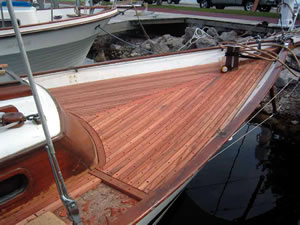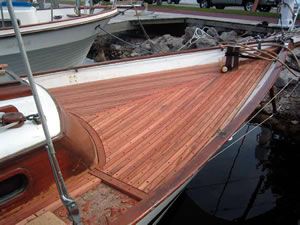Photo courtesy of Patrick Smart

About two miles up the Lumut River in western Malaysia, a local entrepreneur known simply as Mr. Chan ran a small mooring field with a tin-roof club house and a railway slipway. It was inexpensive, and Chans hospitality was renowned. People went to Chans for the camaraderie, for the potlucks, for a haulout . . . When we were cruising, we went for the teak.
A modern teak plantation is like an M.C. Escher painting; you stare, mesmerized, down the rows of evenly spaced trees that seem to stretch forever. The ground sponges under your feet, and the branches overhead seem pruned to cast identical shadows on the ground.
The plantation we toured was sustainable new growth. Harvesting began after eight years, with the older trees fetching higher prices.
If you find a surprisingly cheap, well-equipped, used cruising boat these days, chances are it has a teak deck in dire need of attention.
Typical failure occurs like this: Over-attention wears the deck so thin that the bungs sealing the fastener holes begin to leak. Water enters the sub deck-usually plywood or balsa-and the trapped water travels horizontally through the subdeck, rotting out one section at a time.
The owner of a boat like this has a few options. Fix the deck in piece-meal fashion, sealing bungs, replacing rotted subdeck, and recaulking. Or, more expensive options include removing the teak and either installing new teak or laminating a fiberglass deck. PS contributing writer Joe Minick described in detail the expensive, labor-intensive process of replacing a teak deck in the June 2011 issue (find it online). New installation methods use glue and require no fasteners, eliminating one of the chief contributors to teak-deck failure.
The fasteners on our boat were not the main problem. The previous owners were. They had sanded the deck again and again, until eventually the fasteners were exposed and water entered the sub deck. A thick teak deck that has reached this condition possibly can be salvaged by refastening the deck and adding new bungs. If the boat is pre-1975, the deck might be a half-inch thick, making the possibility of refastening and rebunging more likely. If the deck is thin or too far gone, you will wind up like we did in Lumut, looking for new teak planks.
We eventually settled on some choice quarter-sawn planks from a mill outside of town. The two cracked strip-planks were pulled, the subdeck repaired, and the new planks were fastened and recaulked. The project took a week, including sourcing, milling, and dressing the strips that needed replacing.
I don’t begrudge the owner who decides to replace a teak deck with fiberglass. Although it is an excellent nonskid and insulator, teak is hot to walk on in the tropics. Nevertheless, I find it encouraging that some people like Minick and Patrick Smart, who owns the Cheoy Lee we profiled in last months issue, have decided to stick with teak.
Today, teak can be sourced from sustainable plantations that are genuinely interested in preserving old-growth forests. Although a teak deck does not last forever, if an owner can get beyond the unnecessary obsession with a golden-hued Bristol deck, and instead can allow this marvelous wood to weather naturally, with only light cleaning and regular saltwater rinses, it will last longer than the owner can imagine. And on a wet night, when he finds himself alone on deck, hell be thankful for the teaks outstanding traction.




































